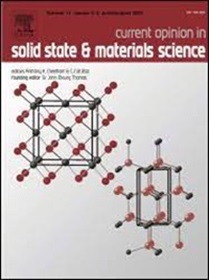Recent advances in understanding iron/steel corrosion: Mechanistic insights from molecular simulations
IF 13.4
2区 材料科学
Q1 MATERIALS SCIENCE, MULTIDISCIPLINARY
Current Opinion in Solid State & Materials Science
Pub Date : 2025-02-26
DOI:10.1016/j.cossms.2025.101216
引用次数: 0
Abstract
Steel structures form the backbone of modern infrastructure, providing strength and durability to buildings, bridges, and other critical constructions. However, iron/steel corrosion is a prevalent issue leading to significant maintenance costs and safety concerns across various industries. Understanding and inhibiting iron/steel corrosion is vital to ensuring the sustainability of these industries. Capturing atomistic scale corrosion mechanisms and interactions using traditional experimental methods is challenging. Recent advances in computational materials chemistry, particularly density functional theory (DFT) and molecular dynamics (MD) simulations have significantly enhanced our understanding of the corrosion mechanism. This review focuses on the latest progresses using DFT and MD simulations to investigate iron/steel corrosion at the atomistic level. We discuss how these methods are employed to understand the fundamental process of oxidation, passivation and depassivation mechanisms, and the role of aggressive agents so that more effective corrosion prevention methods can be developed. This review aims to provide a comprehensive literature study on iron/steel corrosion mechanisms using computational tools and their contribution in understanding and prevention of corrosion.

理解钢铁腐蚀的最新进展:来自分子模拟的机制见解
钢结构是现代基础设施的支柱,为建筑物、桥梁和其他关键建筑提供强度和耐久性。然而,钢铁腐蚀是一个普遍存在的问题,导致许多行业的维护成本和安全问题。了解和抑制钢铁腐蚀对确保这些行业的可持续性至关重要。利用传统的实验方法捕捉原子尺度的腐蚀机制和相互作用是具有挑战性的。计算材料化学的最新进展,特别是密度泛函理论(DFT)和分子动力学(MD)模拟,极大地增强了我们对腐蚀机理的理解。本文综述了利用DFT和MD模拟在原子水平上研究钢铁腐蚀的最新进展。我们讨论了如何使用这些方法来了解氧化,钝化和脱钝化机制的基本过程,以及侵蚀剂的作用,以便开发更有效的防腐蚀方法。本文综述了利用计算工具对钢铁腐蚀机理的综合文献研究,以及它们在理解和预防腐蚀方面的贡献。
本文章由计算机程序翻译,如有差异,请以英文原文为准。
求助全文
约1分钟内获得全文
求助全文
来源期刊

Current Opinion in Solid State & Materials Science
工程技术-材料科学:综合
CiteScore
21.10
自引率
3.60%
发文量
41
审稿时长
47 days
期刊介绍:
Title: Current Opinion in Solid State & Materials Science
Journal Overview:
Aims to provide a snapshot of the latest research and advances in materials science
Publishes six issues per year, each containing reviews covering exciting and developing areas of materials science
Each issue comprises 2-3 sections of reviews commissioned by international researchers who are experts in their fields
Provides materials scientists with the opportunity to stay informed about current developments in their own and related areas of research
Promotes cross-fertilization of ideas across an increasingly interdisciplinary field
 求助内容:
求助内容: 应助结果提醒方式:
应助结果提醒方式:


